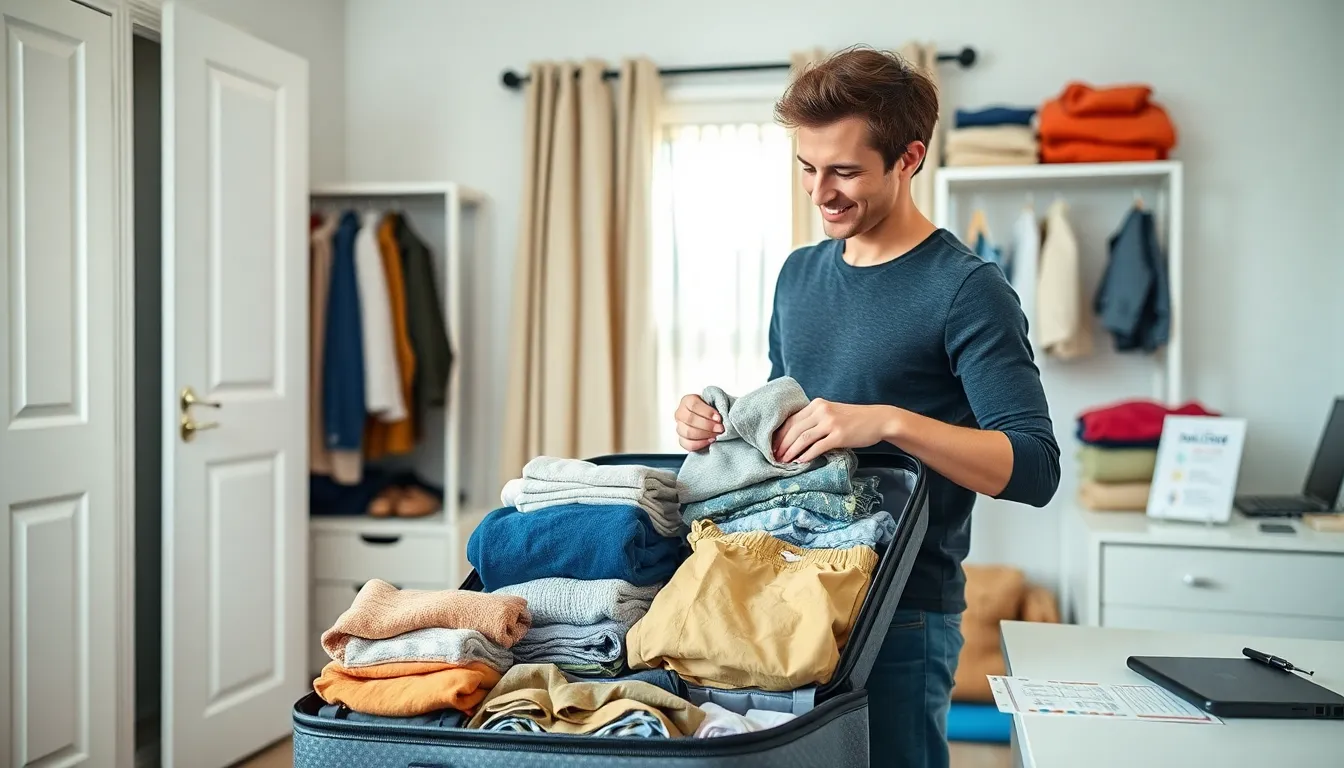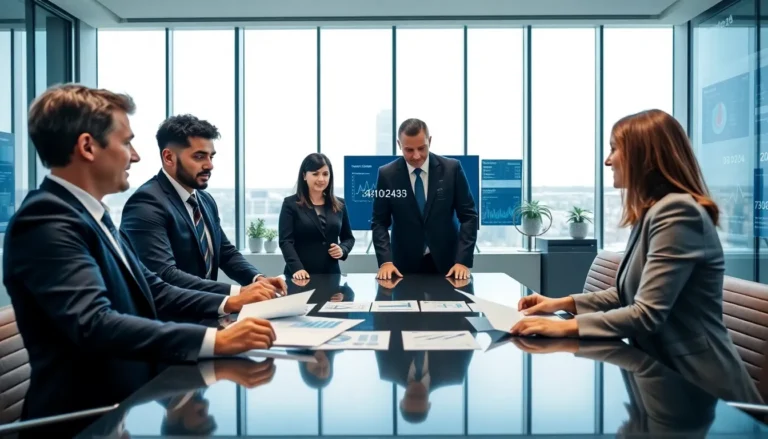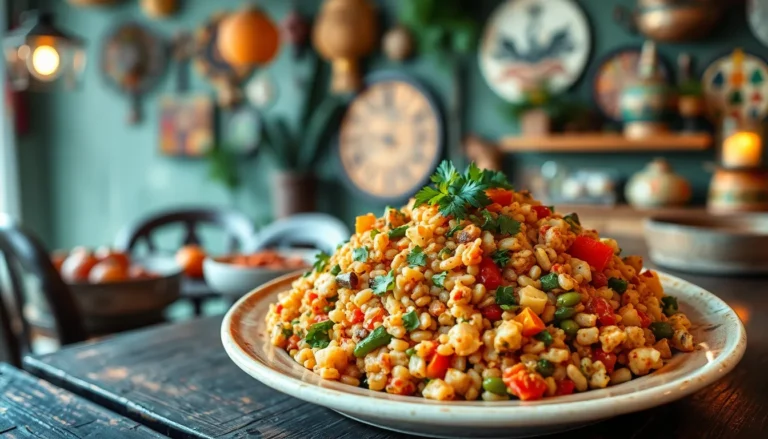Table of Contents
ToggleIn a world where travel often means juggling heavy bags and endless packing lists, minimal packing has emerged as a game changer. Embracing a minimalist approach not only lightens the load but also enhances the travel experience, allowing for greater freedom and spontaneity. Whether it’s a weekend getaway or a month-long adventure, knowing how to pack efficiently can make all the difference.
With the right strategies, anyone can master the art of packing light. From choosing versatile clothing to utilizing space-saving techniques, these minimal packing tips will help travelers streamline their luggage and focus on what truly matters—creating unforgettable memories. Get ready to discover how less really can be more when it comes to packing for your next journey.
Understanding Minimal Packing
Minimal packing simplifies travel by focusing on essentials, reducing the stress of overpacking. It encourages travelers to streamline their packing lists, maximizing freedom and ease during journeys.
What Is Minimal Packing?
Minimal packing involves the practice of carrying only the essentials for a trip, opting for fewer items that serve multiple purposes. This includes selecting versatile clothing that can be mixed and matched, prioritizing lightweight materials, and using compact packing techniques. Travelers adopting this strategy aim to free themselves from bulky luggage and unnecessary gear.
Benefits of Minimal Packing
- Reduced Stress: Lighter bags make navigating airports, train stations, and cities easier. Less weight translates to less physical strain and fewer logistics to manage.
- Time Efficiency: Packing light cuts down on preparation time. A minimalist approach leads to quicker packing and unpacking, allowing more time for exploration.
- Cost Savings: Fewer items can reduce checked bag fees and make traveling on budget airlines more economical. Minimal packing may also eliminate the need for paid checked luggage.
- Improved Mobility: Easier movement enhances spontaneity. Travelers can switch accommodations or transportation modes without the hassle of heavy bags.
- Eco-Friendly: Opting for fewer possessions encourages sustainable travel habits. Minimal packing often results in less waste and a lower carbon footprint.
Essential Packing Strategies

Effective packing enhances the travel experience and supports a minimalist approach. Implementing strategic techniques streamlines the process and maximizes packing efficiency.
Create a Packing List
Creating a packing list establishes clarity and prevents overpacking. Focus on essentials by categorizing items into sections like clothing, toiletries, and electronics. Include only necessary items and specify quantities; for instance, list three shirts instead of a vague “some shirts.” Prioritize multi-use items, like a scarf that works as a blanket or headwear. Cross off items as they’re packed to track progress and ensure nothing is forgotten.
Choose Versatile Clothing
Choosing versatile clothing simplifies packing and expands outfit options. Opt for neutral colors that mix and match easily, allowing for multiple combinations with fewer pieces. Select clothing made from wrinkle-resistant materials for easy maintenance. Prioritize functional items, such as a dress that transitions from day to night or shoes suitable for various occasions. Limit shoe options to two pairs, one for casual wear and another for formal settings, freeing up space in the luggage.
Packing Techniques
Effective packing techniques maximize space and organization in luggage, supporting minimal packing goals. These strategies enhance efficiency and reduce travel stress.
Rolling vs. Folding Clothes
Rolling clothes results in a compact packing method that minimizes wrinkles. Travelers can fit more items into their bags when rolling, allowing for better space management. For instance, lightweight materials like t-shirts and pants roll easily. Folding suits heavier garments like jackets and dress shirts. Choosing rolling for casual wear and folding for structured pieces optimizes luggage space.
Utilizing Packing Cubes
Packing cubes provide a systematic way to organize belongings within a suitcase, promoting easily accessible items. These fabric containers come in various sizes, allowing travelers to group similar items together. For example, one cube can hold pajamas while another contains activewear. Using packing cubes minimizes disorganization, simplifies packing, and enhances retrieval during trips. Overall, these tools streamline the packing process while supporting a minimalist approach.
Minimizing Toiletries and Accessories
Minimizing toiletries and accessories significantly contributes to lightweight packing. By selecting the right products, travelers can save space and simplify their travel routine.
Travel-Sized Products
Travel-sized products are convenient for streamlined packing. Most manufacturers offer toiletries in smaller containers, ideal for short trips. Travelers can also purchase reusable travel-sized containers to transfer essential items like shampoo and conditioner. This approach optimizes space and ensures compliance with airline regulations for carry-on luggage.
Multi-Use Items
Multi-use items enhance packing efficiency. Dual-purpose products, such as a moisturizer with SPF or a shampoo that doubles as a body wash, minimize the number of bottles travelers need to pack. He or she can further streamline accessories by choosing a single hair tool, such as a hybrid straightener and curling iron, instead of packing multiple devices. Selecting versatile items reduces clutter while ensuring all essential needs are met on the journey.
Tips for Different Types of Travel
Travelers benefit from tailored packing strategies based on the trip’s duration and purpose. Efficient packing leads to a more enjoyable travel experience across various trip types.
Minimal Packing for Weekend Trips
Travelers heading out for weekend trips can optimize their packing by focusing on essentials and versatility.
- Choose a versatile outfit: Pack clothing items that mix and match easily, such as a pair of neutral pants and a few tops.
- Limit the footwear: Select one comfortable pair of walking shoes for day activities and one pair of versatile sandals or flats for evening outings.
- Minimize toiletries: Opt for travel-sized containers and multi-use products to reduce space and meet airport regulations.
- Utilize a compact bag: Use a small backpack or a weekender bag that fits personal items without overwhelming.
- Plan activities: Prepare a loose itinerary that helps pinpoint the types of clothes and gear necessary for planned excursions, ensuring there’s no need to overpack.
Minimal Packing for Long Journeys
Long journeys require strategic packing to maintain comfort and convenience over extended periods.
- Invest in a quality suitcase: Opt for a lightweight, durable suitcase that maximizes packing efficiency while minimizing weight.
- Select multifunctional clothing: Choose garments suitable for various climates and occasions, such as a jacket that layers well or pants that transition from casual to formal.
- Compact essentials: Utilize space-saving techniques, like rolling and packing cubes, to maximize luggage space while keeping items organized.
- Pre-pack a laundry bag: Bring a dedicated laundry bag to separate dirty clothes; this keeps everything else organized and fresh.
- Create a comprehensive packing list: Detail all necessary items, including electronics and chargers, to ensure nothing crucial is left behind.
Travelers who implement these focused strategies enhance their packing efficiency, leading to enjoyable weekend getaways or lengthy adventures without the burden of excessive baggage.
Embracing minimal packing transforms the travel experience into one of ease and enjoyment. By focusing on essentials and versatile items travelers can navigate their journeys with greater freedom and spontaneity. This approach not only lightens the load but also enhances mobility and reduces stress.
Implementing effective packing strategies like rolling clothes and using packing cubes streamlines organization and maximizes space. Prioritizing multi-use products further supports a minimalist mindset while ensuring all needs are met.
Ultimately minimal packing encourages travelers to prioritize memorable experiences over logistics. With these tips in hand anyone can embark on their next adventure feeling prepared and unburdened.




